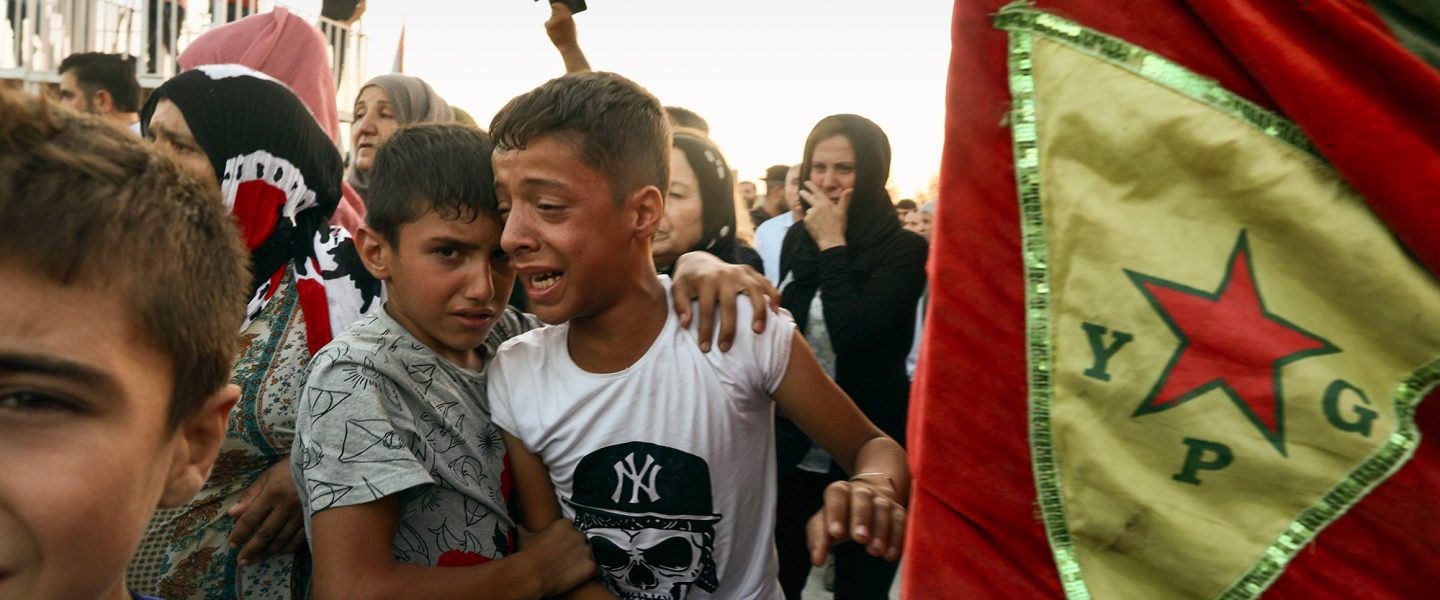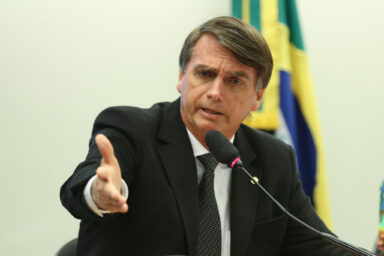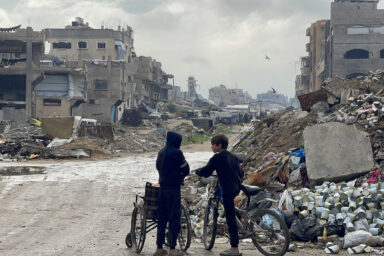As the US seeks Turkey’s cooperation against Russia, Turkish forces are escalating attacks and threatening an invasion in northeast Syria against Kurds and other erstwhile partners in the war against ISIS.
|
Listen To This Story
|
QAMISHLI, Syria — The workday was ending on August 6 in the industrial zone of Qamishli, a city of roughly a quarter-million people in the Autonomous Administration of North and East Syria (AANES) near the Syrian-Turkish border, when 14-year-old Ahmad Husain called his father to tell him a customer was at his automobile shop.
Parked outside the shop where Ahmad and his 16-year-old cousin, Aheng Husain, were gathered was a white Hyundai pickup truck — the apparent target of a suspected Turkish drone strike that, minutes after Ahmad’s final phone call, killed the boys along with two others and injured two more people, including Ahmad’s father, Ali.
The Internal Security Forces of the Autonomous Administration: Four people, including two children, were killed in a Turkish drone targeting a car in the city of Qamishlo, northeastern Syria.#aanes #SDF pic.twitter.com/0cqShHgWkg
— Shilan Chikh Mousa (@SChikhmousa) August 6, 2022
The next day, with shops shuttered to honor the dead, the Syrian Democratic Forces (SDF) — a coalition of Kurdish, Arab, and other ethnic groups that is the armed authority in the region — announced that Mazkum Saadeddin Asaad, one of the four people killed in the attack, was one of its members.
Though the SDF has been a vital partner in the fight against ISIS, Turkey sees it as a dangerous enemy. According to Ankara, the Kurdish People’s Protection Units (YPG) — a militia group that forms the backbone of the SDF — is an offshoot of the Kurdistan Workers’ Party (PKK), a leftist political and guerrilla movement that has waged a decades-long insurgency against Turkey, and which the US, Turkey, and the EU declare a terrorist organization.
Four days later, local officials announced that Yusuf Mohamed al-Rabani, a leader in an Iranian Kurdish group connected to the PKK who was visiting the region, also died after succumbing to injuries sustained in the attack.
It’s unclear whether either man was the intended target. The Turkish Foreign Ministry did not respond to requests for comment and has not commented publicly on the attack, but Turkey has deliberately targeted SDF forces before — and the SDF has held Turkey responsible.
Declaring its right to self-defense, the SDF announced on August 11 that it had killed 23 Turkish troops in retaliation for the drone strike and other attacks this month that claimed seven dead civilians and another 17 injured.
This back-and-forth is one of the latest episodes in a bloody, slow-burn conflict that’s pitted Turkey, a key NATO member and ostensible partner in the US-backed war on terror, against Kurdish forces, a Washington ally in both the Syrian conflict and the fight against ISIS.
This long-simmering dispute has fresh relevance following Russia’s invasion of Ukraine. The United States is seeking Turkey’s cooperation in building a solid united front against Moscow. Turkish President Recep Tayyip Erdoğan, meanwhile, has sought to use Turkey’s role in NATO as leverage in its ongoing campaign against Kurdish groups — including a controversial fourth invasion of Syria.
This forces the United States to undergo a precarious balancing act between opposing Turkey’s military adventurism and minding its security concerns in order to ensure cooperation against Russia.
Caught in the middle are the people of northeast Syria.
AANES officials criticize Turkey and its rebel proxies for ongoing attacks like the fatal drone strike. They dismiss claims that Kurds in their territory pose a threat to Turkish security, and bemoan a constant drumbeat of drone attacks, environmental degradation, and what they identify as other deliberate Turkish efforts to make life in northeast Syria untenable.

“It’s unbelievable for anyone to think that the SDF is trying to threaten Turkey or make problems against Turkey, because we know our size compared to Turkey,” Mustafa Mashayikh, deputy leader of the Kurdish Democratic Unity Party, the third largest Kurdish party in Syria, said in an interview. “How can we make problems with a big country like that? It’s unbelievable.”
Old Wounds, New War
For more than 40 years, Turkey has been locked in an ongoing struggle with political organizations and armed elements representing the Kurdish people, an ethnic group called “the world’s largest stateless nation.”
The geographic region understood as “Kurdistan” stretches across Syria, Iraq, Iran, and Turkey. Kurds in all four countries have long faced discriminatory and oppressive policies, such as the banning of the Kurdish language. However, the chaos in Syria stemming from its decade-old civil war created an opportunity for the Kurds.
In far northeastern Syria, where President Bashar al-Assad’s Damascus government has little reach, Kurdish armed groups and their allies established the Autonomous Administration of Northeast Syria. There, a revolutionary democratic system has secured what local Kurds told me is the greatest amount of rights they’ve enjoyed in modern times.
Turkey fears that an established, strong Kurdish presence in northern Syria will embolden the PKK and pose a serious national security threat. Conflict between the PKK and Turkey in southeastern Turkey and northern Iraq has left almost 40,000 dead.
The SDF and its Kurdish base have served as a critical US partner in Washington’s global coalition against the Islamic State. Earlier this year, when the Biden administration asked Congress for $541 million to fund anti-ISIS efforts, $183 million were earmarked to train and equip US partners in Syria, especially the SDF.
This relationship has angered Erdoğan, who considers the YPG and PKK to be one and the same.
However, while the groups share certain ideological ties and sympathies, most experts argue that they are separate.
“The argument that this is sort of one continuous organization and that the SDF is just sort of a subsidiary of the PKK is something that most people would push back against pretty heavily,” said Calvin Wilder, an analyst at the New Lines Institute — a DC-based think tank — who researches non-state actors in Syria. “The argument that there’s relationships between the two and that PKK members have gone on to join the SDF is truly something that has happened, but that doesn’t necessarily make them the same organization.”

Amid Erdoğan’s threats to launch a fourth incursion into northeast Syria, Turkey and its rebel proxy, the Syrian National Army (SNA), continue to carry out a steady campaign of drone strikes, shelling, and alleged ecological warfare against AANES territory.
With Syria divided among roughly four spheres of influence that include Russian, Iranian, and US troops and their respective partners, as well as Turkish forces, Ankara has sought to receive approval for its operation from Moscow, Tehran, and Washington. In a rare example of consensus, the US, Iran, and Russia have all pushed back against an invasion, warning that it would further destabilize the region by renewing the Syrian civil war, an 11-year-long conflict that has left roughly half a million dead and displaced half of Syria’s pre-war population. But while Erdoğan appears dissuaded for the time being, many AANES residents believe an invasion is still likely, according to interviews with WhoWhatWhy.
Turkey, meanwhile, is using its position within NATO as leverage against the Kurds. In May, Erdoğan opposed Finland and Sweden’s membership, arguing that the Nordic countries provided a “safe haven” for the PKK. A month later, Erdoğan reversed his position after Finland and Sweden reached an agreement with Turkey to cooperate on its national security concerns and to lift arms embargoes imposed following Turkey’s 2019 invasion of Syria.
Experts believe the United States will be similarly pressured into cutting its support for Kurdish forces in the region.
“It’s inevitable that as US policy pans out of Syria, focusing instead on Russia, Turkey’s importance to Washington as an influential and militarily powerful Black Sea nation will increase — to the YPG’s disadvantage,” Soner Cagaptay, director of DC-based think tank Turkish Research Program at the Washington Institute, wrote on Twitter.
Some Turkish policies undermine Russian interests. Turkey has closed the key Bosporus and Dardanelles straits to warships — essentially freezing Russia’s naval presence in the Black Sea — and has closed its airspace to Russian aircraft. Turkey has also supplied Ukraine with drones employed to kill Russian troops.
In other instances, Turkey has helped Russia, as with the decision to keep open the TurkStream pipeline, which has become the main supplier of Russian gas to Europe. Turkey has also served as a mediator between Moscow and Kyiv, most notably by brokering an agreement with the United Nations to resume grain exports from Ukraine.
Meanwhile, Kurds across AANES have expressed frustration with the US over a perceived silence on Turkish attacks. The most recent example is a statement on August 11 from the US-led Global Coalition against ISIS “about recent military activity in northeast Syria.”

The statement emphasized the threat still posed by ISIS while offering a vague rebuke against “actions by third party actors who attempt to disrupt those operations and threaten the security of the civilian population.”
“We denounce the killing of civilians by any and all armed groups,” said US Army Maj. Gen. John Brennan, without naming either Turkey or the Kurds — or any victims.
Drones Overhead
On a hot summer afternoon, Nabil Warde, spokesperson of the Khabur Guards, an Assyrian defense force affiliated with the SDF, sat in a basement office in Tal Tamr, a town just miles away from SNA-controlled territory.
Around the room hung martyrdom photos commemorating Assyrian fighters killed in battles against ISIS. At the far end of the room, a flag of Abdullah Öcalan, founder of the PKK, whom Turkey has imprisoned since 1999, decorated the wall.
Outside, a Turkish drone patrolled the sky.
Tal Tamr sits some 6 miles away from territory seized by Turkey and the SNA during its last offensive in 2019. Its residents include Kurds, Arabs, Christians, Assyrians, Syriacs, and Armenians. Like most areas along the front line, it regularly comes under shelling, though the locations that are hit are almost always civilian.
Military personnel, Warde noted, are usually killed by drone strikes.
We had originally planned to travel with Warde to the frontline where Khabur Guards were positioned against Turkish forces and the SNA, but the Turkish drone made it unsafe to move.
Turkey has long targeted SDF forces and their allies with drones, but Warde and other officials say that attacks have increased following a meeting between Erdoğan, Russian President Vladimir Putin, and Iranian leadership in Tehran in mid-July. During the summit, Erdoğan sought approval for his latest Syrian invasion but was rebuffed. While that setback and US pressure seems to have at least postponed an offensive, Turkey and the SNA continue to launch a daily mix of arbitrary and targeted attacks against military and civilian targets in the Autonomous Administration.

The increased presence of drones has proven especially problematic. Without anti-aircraft weapons, the SDF and its allies remain helpless against Turkish air power — a dilemma that has led many AANES officials to request that the US impose a no-fly zone to block Turkish aircraft.
https://twitter.com/RojavaIC/status/1559581777932451842
In the weeks following the Tehran summit, suspected Turkish drone strikes have killed scores of SDF members and leaders. These include Salwa Yusuf, a renowned female commander, who died in a drone attack near Qamishli on July 22 alongside two other female commanders. In a statement, the US Middle East military command expressed condolences for her death, but carefully refrained from referencing Turkey.
While Washington has called for Turkey to put off its invasion, it has been less attentive to Turkish and SNA drone strikes and shelling, something that has frustrated Warde and other officials who note that the attacks are a violation of a 2019 ceasefire agreement.
“Until now, there has been no ceasefire at all,” Warde said. “There are regular attacks by drones, by artillery, by mortars against different places in the area.”
The Monitoring and Observation Desk — an independent, volunteer-based agency in northeast Syria that tracks military attacks and other local developments — recorded 2,170 violations of the agreement in June, resulting in the death or injury of 31 people, including children.
“It’s a very difficult situation for the US,” said Wilder, the Washington-based analyst. “Part of the reason that they don’t want to supply the military equipment that the SDF wants, and particularly like the anti-air equipment, is the US is just obviously fundamentally not willing to go shoot down the planes and drones of a NATO ally.”
The attacks and increased presence of drones have restricted military movement and meant that our time with Warde would be limited to an interview in the defense force’s underground headquarters.
Warde said that after years of war and conflict, many residents have fled Tal Tamr and the surrounding villages, leaving some places nearly abandoned. Those who can’t leave or choose to stay live in regular fear of the next attack, never knowing when another burst of artillery fire will slam into their village or a drone strike will maim innocent bystanders.
That fear, Warde added, has also worsened crop shortage caused by drought and water shortages, with some residents too afraid to plant crops.

According to Warde, Turkey’s motive with the artillery and drone strikes is to drive people out of their homes and to turn those who stay against local authorities in a bid to crush the Autonomous Administration’s nascent multiethnic democratic system.
Turkey seeks to “finish this democratic situation which now exists in this region,” he said, accusing Moscow and Iran of also collaborating with Ankara to “make it disappear.”
In an acknowledgment of its difficult position, the SDF signed a military agreement with al-Assad’s Syrian regime in July, allowing government forces to strengthen their positions in AANES territory.
The arrangement has received mixed responses, with some viewing it as an unsavory pragmatic necessity in the face of an existential threat.
“The SDF was forced to do that,” said Mashayikh, the deputy leader of the Kurdish Democratic Unity Party. “If they [don’t] do that, they will be erased.”
“They are like a guy drowning in water,” he continued. “He will catch on to any straw he can just to save his life.”
Others are more skeptical, noting that the agreement allows the regime to reestablish a foothold in territory that it hasn’t held in 10 years, and that Russia and Iran may also use the deal as an opportunity to move their own forces into AANES.
“The SDF is quite clear-eyed about this,” said Wilder. “From the regime’s perspective, if they move back in, they would like to stay. They don’t want to do that as a temporary two-month thing and then pack up their bags and head back out.”
For his part, Warde said he welcomes the agreement.
“We are all Syrians,” he said. “The duty of each person from Syria is to defend the land against any attacker.”

Environmental Warfare
The largest dam in Syria, the 18-story-tall Tabqa Dam is the main producer of electricity for the Autonomous Administration, according to the dam’s director, Walat Darwish. (The dam’s recapture by the SDF from Islamic State fighters was a dramatic moment in the war against ISIS.) The dam’s 25-mile-long reservoir is also the primary supply of water for drinking and irrigating crops.
But today, the water along the wall of the Tabqa Dam is significantly lower than it was after the recapture — a looming environmental crisis that AANES officials claim is part of a deliberate attack by Turkey.
Both the Euphrates and Tigris rivers that supply the “Fertile Crescent” of antiquity originate in Turkey. Since the 1960s, Turkey, Syria, and Iraq have squabbled over precious water. Per a 1987 agreement, Turkey is required to provide Syria with 500 cubic meters per second of water along the Euphrates River. But since the SDF took control of the dam after an intense battle against ISIS in 2017, Autonomous Administration officials claim Turkey has reduced the water supply. Turkey, whose foreign ministry did not reply to requests for comment for this article, has previously denied cutting water along the Euphrates. But as of April, the water level has dropped to under 250 cubic meters per second, which has caused the dam’s storage volume to decrease from 14.6 billion cubic meters down to 9 billion.
AANES authorities say Turkey has deliberately cut the supply of water along the Euphrates River — thereby draining the dam’s reservoir — as a form of ecological warfare in a bid to assert additional pressure against a region already beset by climate change.
“Turkey uses this as a political pressure card,” said Orhan Kamal, coordinator of the Synergy Association for Victims in North and East Syria, a nonprofit that documents human rights violations. “If they want anything, they cut the water so that more than a million people who live in these areas lack water.”
Reduced water levels have caused the dam to decrease the amount of electricity it can produce, Darwish said. The dam was once able to generate up to 12 hours of electricity. Today, it can only provide up to two hours for some places, forcing AANES residents to be more reliant on gasoline-powered generators.
Decreased water supplies have also impacted crop production, noted Kamal, particularly wheat, northeastern Syria’s staple cash crop.
“If they don’t have water for drinking, how can they plant?” he asked.
Lower levels have also caused water pollution to increase, fish to die off, and diseases to spread. The main illness is leishmaniasis, which spreads through still bodies of water and causes large, painful sores, said Ciwan Mustafa, co-chair of the AANES Health Board. If left untreated, it can spread to internal organs and even cause death. As of August, the number of leishmaniasis cases has exceeded 70,000, he added.
For now, AANES has been able to handle and treat patients, but only because of the help of NGO Monitor, a research institute. If Turkey invades, Mustafa expects NGO Monitor to leave as many other nonprofits did in 2019. That would leave AANES without the capacity to treat patients at a moment when the region’s health sector is already suffering from 11 years of conflict.
“Monitor alone is not enough,” Mustafa said. “Every year, the problem gets worse and worse and worse. The problem was not so big in 2011, but every year since 2011, it’s been getting worse and worse and worse. There have been more and more cases.”

While leaders of the autonomous region are not in regular diplomatic communication with Ankara, Mustafa said Turkey is well aware of the impact of the water shortage.
“They know about it, but they don’t care,” he said. “On the contrary, as soon as they knew about it, they increased this action against us to worsen the problem, to worsen the effects of this. It is a war, you know.”
As with the military strikes, Darwish views the reduction of water as a deliberate attack by Turkey intended to make life in AANES unbearable in order to drive people out.
Like many others, he believes that Turkey’s ultimate objective is to eliminate AANES, and that Ankara fears that the multiethnic democratic system of governance practiced in AANES could one day be demanded by its own Kurdish and ethnic minority groups.
Turkey “knows this is the source of life for northeast Syria,” Darwish said. “This will force people to flee.”
Steadfast
Two days after the drone strike in Qamishli, hundreds of people gathered for the funeral of Ahmad, Aheng, and Shamdeen Ismail.
A motorcade carrying their caskets and escorted by a sea of mourners solemnly made its way to Delil Saroukhan Martyrs’ Cemetery, a graveyard filled with mostly fallen YPG and PKK fighters from Qamishli.
At the graveyard’s entrance, the caskets were lifted from ambulances and carried to a platform where family and friends gathered to say their final goodbyes. As mourners wept, speakers denounced Turkey while declaring the steadfastness of Kurds and other AANES residents.
“Through this dirty act they try to stop us,” said one of the speakers, Abdulkarim Saroukhan. “But they can’t.”
As the three caskets disappeared into the earth, Ahmad’s mother, Faiza, sat away with other women.

“He loved birds who are singing,” she said, her eyes heavy with grief. “And he loved riding motorcycles. It was his dream to own one.”
The day before, Hamden Nabi, co-chair of the city’s Industrial Zone Office, sat in his autotrade shop with friends.
A former YPG member and the brother of two others who had been killed fighting ISIS, he squarely blamed Turkey for the attack.
“There are some enemies that have ethics,” Nabi said. “But this enemy does not have ethics.”
Nabi had been only 160 feet away from the strike. When he rushed over to the scene, he found decapitated children.
“The only crime and sin of these children is that they were born Kurdish,” he continued.
Wiping away tears as he described the aftermath of the attack, Nabi’s voice took on a defiant tone as he accused Turkey of attempting to eradicate AANES of its residents.
“We promise, by the blood of the two children killed yesterday by Erdoğan, in every way,” he said. “We will resist, we will not abandon our lands.”
“This is our land. We cannot exist without our land.”
Five days later, another civilian and two SDF fighters were killed in another drone strike, as the bloodiest month for aerial attacks continued. And it was only August 11.
Yesterday afternoon, a Turkish drone attack targeted a car in Mulla Sabat, west of Qamishlo. According to local sources, 2 SDF soldiers & a civilian were killed in the attack. Already, Turkish drone attacks have been the deadliest in August than any other month in 2022. pic.twitter.com/rMr2Qmy5m6
— Rojava Information Center (@RojavaIC) August 11, 2022




